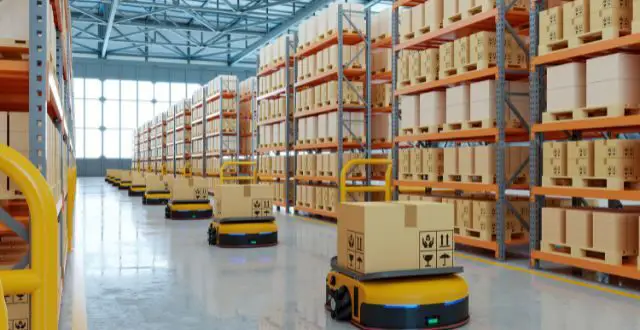In today’s fast-paced business world, effective warehouse management is a critical component of success. Traditional warehouse management solutions are evolving to meet the demands of the digital age. One of the most notable innovations is the Warehouse Asset Management System (WAMS), a technology-driven solution that leverages automation and data analytics to streamline operations.
In this blog post, we’ll explore the advantages of WAMS over traditional warehouse management systems and delve into the role of technology in modern warehouse management.
The Evolution of Warehouse Management
Traditional warehouse management often relied on manual processes, paper records, and human intervention. While effective to some extent, these systems were prone to errors, lacked real-time visibility, and hindered the efficiency of warehouse operations. With the advent of technology, warehouse management has undergone a significant transformation. WAMS represents the next phase in this evolution, introducing a range of benefits that redefine the way warehouses are managed.
In addition to enhancing efficiency and accuracy, WAMS systems can also serve as a bridge if you looking for customer service, allowing warehouse teams to respond quickly to customer inquiries, provide real-time order tracking, and meet the growing expectations for responsive and efficient service in the e-commerce era. This integration of WAMS with customer service is a testament to the adaptability and versatility of modern warehouse management solutions.
Precision and Efficiency
Warehouse Asset Management Systems bring a host of advantages to the table. At the forefront is the precision and efficiency they offer. Automation in data collection, inventory tracking, and order fulfillment minimizes the margin for human error. The result is a reduction in costly mistakes, accurate stock levels, and improved order accuracy, all of which contribute to a smoother, more reliable operation.
The Power of Data Analytics
One of the standout features of WAMS is the ability to provide real-time visibility into warehouse operations. With advanced data analytics and reporting, managers can monitor the movement of assets, inventory levels, and workforce productivity in real time. This visibility empowers decision-makers to respond quickly to changing conditions, make data-driven choices, and optimize warehouse performance.
The Customer-Centric Approach
In a world where e-commerce has become the norm, efficient order fulfillment is vital. WAMS plays a pivotal role in streamlining this process. Automated order picking and packing, reduces order processing times and ensures that customer orders are prepared and dispatched promptly. This customer-centric approach enhances the overall shopping experience and boosts customer satisfaction.
No More Overstock or Stockouts
Balancing inventory levels is a challenging task for warehouse managers. Overstocking ties up capital, while stockouts can lead to lost sales and dissatisfied customers. WAMS helps tackle this issue by providing real-time insights into inventory levels and trends. Managers can make informed decisions about restocking and managing inventory, ensuring that products are always available when needed without excessive carrying costs.
Empowering the Workforce
WAMS contributes to a more productive workforce. By automating routine tasks and providing clear guidance on order fulfillment and inventory management, it empowers employees to focus on more value-added activities. This can lead to increased job satisfaction and higher morale among warehouse staff.
The Bottom Line Impact
Warehouse operations can be costly, and minimizing expenses is a key concern. WAMS can have a direct impact on reducing operating costs. With streamlined processes, accurate inventory management, and optimized workforce productivity, warehouses can operate more efficiently, leading to cost savings that positively impact the bottom line.
Adapting to Changing Needs
A significant advantage of WAMS is its scalability. Whether your warehouse is small or large, this system can adapt to your changing needs. As your business grows, WAMS can scale up to accommodate increased inventory, more complex operations, and higher order volumes. This flexibility is crucial for businesses experiencing growth or those that operate in seasonal markets.
The Role of Technology in Modern Warehouse Management
Technology has become the driving force behind modern warehouse management. With WAMS, businesses are equipped with tools and resources that enhance their operational capabilities. Real-time data analytics, automation, and advanced reporting features provide a foundation for decision-making that’s rooted in insights and efficiency.
Embracing Innovation
The future of warehouse management is promising, with technology playing an even more significant role. As WAMS systems continue to evolve, we can expect to see further integration of emerging technologies such as the Internet of Things (IoT), artificial intelligence (AI), and robotics. These innovations will lead to even greater automation, predictive analytics, and adaptive warehouse solutions that can handle complex, ever-changing logistics.
A Strategic Investment
While the advantages of WAMS are clear, implementing such a system is a strategic investment. Businesses must consider factors such as cost, integration with existing systems, and staff training. A well-planned implementation can ensure a smooth transition and a rapid return on investment (ROI).
A Competitive Advantage
Inventory accuracy is a cornerstone of successful warehouse management. With traditional systems, discrepancies, and errors can be common, leading to issues like overstock or stockouts. WAMS improves inventory accuracy through real-time tracking, reducing the likelihood of costly mistakes. Accurate inventory levels enable businesses to make informed decisions, reduce carrying costs, and maintain a competitive edge in a dynamic marketplace.
Mitigating Risks
Security is a paramount concern in warehouse management. WAMS provides advanced security features to protect assets, inventory, and the entire operation. Access controls, real-time monitoring, and automated alerts help mitigate risks such as theft, unauthorized access, and tampering. By enhancing security, WAMS not only safeguards valuable assets but also contributes to peace of mind for warehouse managers and owners.
Seamless Connectivity
The supply chain is a complex network, and the integration of warehouse management with the broader supply chain is crucial. WAMS systems facilitate seamless connectivity and data exchange with other supply chain components, such as transportation management systems (TMS) and enterprise resource planning (ERP) systems. This integration optimizes the entire supply chain, enabling a synchronized flow of goods from suppliers to customers, reducing lead times, and enhancing overall operational efficiency.
Meeting Environmental Goals
In an era of increasing environmental awareness, sustainability in warehouse management is gaining prominence. WAMS contributes to green warehousing by minimizing waste and energy consumption. Through accurate demand forecasting, reduced paper usage, and optimized routes for order fulfillment, WAMS helps warehouses operate in a more environmentally friendly manner, meeting sustainability goals and aligning with corporate social responsibility efforts.
Conclusion
Warehouse Asset Management Systems (WAMS) represent a transformative shift in warehouse management, offering a multitude of advantages over traditional systems. From enhancing inventory accuracy to improving security and seamlessly integrating with the broader supply chain, WAMS delivers a competitive edge in today’s fast-paced business world.
As businesses embrace the technology-driven future of warehouse management, they can anticipate improved efficiency, cost savings, and sustainability, which are vital components of success in a dynamic and competitive marketplace.
 khamush.com Lifestyle | Motivation | Poems
khamush.com Lifestyle | Motivation | Poems



